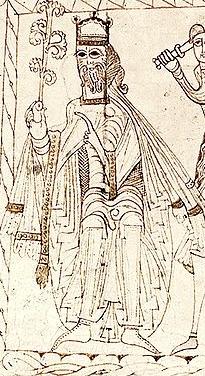
Alphons is a male given name recorded from the 8th century in the Christian successor states of the Visigothic kingdom in the Iberian peninsula. In the later medieval period it became a standard name in the Hispanic and Portuguese royal families.
The 1380s was a decade of the Julian Calendar which began on January 1, 1380, and ended on December 31, 1389.

Ferdinand is a Germanic name composed of the elements farð "journey, travel", Proto-Germanic *farthi, abstract noun from root *far- "to fare, travel", and nanth "courage" or nand "ready, prepared" related to Old High German nendan "to risk, venture."

Alfonso VII, called the Emperor, became the King of Galicia in 1111 and King of León and Castile in 1126. Alfonso, born Alfonso Raimúndez, first used the title Emperor of All Spain, alongside his mother Urraca, once she vested him with the direct rule of Toledo in 1116. Alfonso later held another investiture in 1135 in a grand ceremony reasserting his claims to the imperial title. He was the son of Urraca of León and Raymond of Burgundy, the first of the House of Ivrea to rule in the Iberian peninsula.
Queen Isabella may refer to:
Queen Catherine may refer to:

Eleanor is a feminine given name, originally from an Old French adaptation of the Old Provençal name Aliénor. It was the name of a number of women of royalty and nobility in western Europe during the High Middle Ages. The name was introduced to England by Eleanor of Aquitaine, who came to marry King Henry II. It was also borne by Eleanor of Provence, who became Queen consort of England as the wife of King Henry III, and Eleanor of Castile, wife of Edward I.
Queen Margaret may refer to:
King Charles most commonly refers to:
King Ferdinand may refer to:
Isabella of Majorca (1337–1406) was the titular Queen of Majorca and Countess of Roussillon and Cerdanya from 1375 to her death. She was the last titular monarch of Majorca.
A queen mother is a former queen, often a queen dowager, who is the mother of the reigning monarch. The term has been used in English since the early 1560s. It arises in hereditary monarchies in Europe and is also used to describe a number of similar yet distinct monarchical concepts in non-European cultures around the world. The rank does not go to all mothers of monarchs though. A mother of a ruling monarch may only be referred to as Queen Mother if she was a Queen Consort as opposed to a Princess Consort.

Ferdinand II was King of Aragon from 1479 until his death in 1516. As the husband of Queen Isabella I of Castile, he was also King of Castile from 1475 to 1504. He reigned jointly with Isabella over a dynastically unified Spain; together they are known as the Catholic Monarchs. Ferdinand is considered the de facto first king of Spain, and was described as such during his reign, even though, legally, Castile and Aragon remained two separate kingdoms until they were formally united by the Nueva Planta decrees issued between 1707 and 1716.
Katherine is a feminine given name.
Yolande, Yolanda, Violant or Violante of Aragon may refer to:
Queen Beatrice may refer to:
This page is based on this
Wikipedia article Text is available under the
CC BY-SA 4.0 license; additional terms may apply.
Images, videos and audio are available under their respective licenses.




